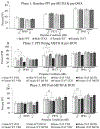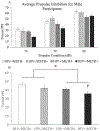Both HIV and Tat expression decrease prepulse inhibition with further impairment by methamphetamine
- PMID: 32891668
- PMCID: PMC7750302
- DOI: 10.1016/j.pnpbp.2020.110089
Both HIV and Tat expression decrease prepulse inhibition with further impairment by methamphetamine
Abstract
HIV infection and methamphetamine (METH) use are highly comorbid and represent a significant public health problem. Both conditions are known to negatively impact a variety of brain functions. One brain function that may be affected by HIV and METH use is sensorimotor gating, an automatic, pre-conscious filtering of sensory information that is thought to contribute to higher order cognitive processes. Sensorimotor gating is often measured using prepulse inhibition (PPI), a paradigm that can be conducted in both humans and animals, thereby enabling cross-species translational studies. While previous studies suggest HIV and METH may individually impair PPI, little research has been conducted on the effects of combined HIV and METH on PPI. The goal of this cross-species study was to determine the effects of METH on PPI in the inducible Tat (iTat) mouse model of HIV and in people with HIV. PPI was measured in the iTat mouse model before, during, and after chronic METH treatment and after Tat induction. Chronic METH treatment decreased PPI in male but not female mice. PPI normalized with cessation of METH. Inducing Tat expression decreased PPI in male but not in female mice. No interactions between chronic METH treatment and Tat expression were observed in mice. In humans, HIV was associated with decreased PPI in both men and women. Furthermore, PPI was lowest in people with HIV who also had a history of METH dependence. Overall, these results suggest HIV and METH may additively impair early information processing in humans, potentially affecting downstream cognitive function.
Keywords: HIV; Methamphetamine; Prepulse inhibition; Sensorimotor gating.
Copyright © 2020 Elsevier Inc. All rights reserved.
Conflict of interest statement
CONFLICT OF INTERESTS
None of the authors have any conflicts of interest to report.
Figures



References
-
- Abdul-Monim Z, Reynolds GP, Neill JC, 2003. The atypical antipsychotic ziprasidone, but not haloperidol, improves phencyclidine-induced cognitive deficits in a reversal learning task in the rat. J Psychopharmacol 17, 57–65. - PubMed
-
- Arai S, Takuma K, Mizoguchi H, Ibi D, Nagai T, Takahashi K, Kamei H, Nabeshima T, Yamada K, 2008. Involvement of pallidotegmental neurons in methamphetamine- and MK-801-induced impairment of prepulse inhibition of the acoustic startle reflex in mice: reversal by GABAB receptor agonist baclofen. Neuropsychopharmacology 33, 3164–3175. - PubMed
-
- Braff DL, Geyer MA, 1990. Sensorimotor gating and schizophrenia. Human and animal model studies. Arch Gen Psychiatry 47, 181–188. - PubMed
-
- Braff DL, Geyer MA, Swerdlow NR, 2001. Human studies of prepulse inhibition of startle: normal subjects, patient groups, and pharmacological studies. Psychopharmacology (Berl) 156, 234–258. - PubMed
-
- Carey CL, Woods SP, Gonzalez R, Conover E, Marcotte TD, Grant I, Heaton RK, Group H, 2004. Predictive validity of global deficit scores in detecting neuropsychological impairment in HIV infection. J Clin Exp Neuropsychol 26, 307–319. - PubMed
Publication types
MeSH terms
Substances
Grants and funding
LinkOut - more resources
Full Text Sources
Other Literature Sources
Medical

